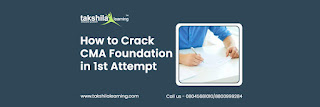Tips for crack CMA Foundation exam
1. Make sure the strategy is feasible: I've suffered from a lack of effective scheduling on numerous occasions because my plans were always superficial because I overestimated myself.
As a result, we must recognise that constructing an efficient study schedule involves time, effort, and an awareness of our own time.
A well-thought-out plan guarantees that you don't fall behind as the exam approaches and that you cover all of the important CMA exam subjects.
2. SMART Technique (Specific, Measurable, Attainable, Relevant, and Time-bound):
One strategy to ensure that your plan is effective is to use the SMART technique. The SMART method ensures that the chosen plan or target takes precedence over all other objectives. The SMART approach asks you to set goals based on the features listed below:
Specific: Goals should be clear and concise.
Measurable: You should be able to track your progress toward your goal. For example, instead of covering the entire syllabus of topic X, my goal should be to cover three of its chapters. I was able to successfully evaluate whether I fulfilled the target before the end of my deadline using this technique.
Achievable: "Today, I'll finish the entire course!" That, of course, sounds ludicrous! As a result, be certain that your objectives are attainable.
Goals should be practical and relevant to your preparation, just like they should be feasible. Just because your friend was the first to finish subject X doesn't mean you should follow suit. Determine which areas make the most sense to concentrate on and set a short-term objective for them.
Timely: As mentioned in the first guideline, make sure your calendar leaves enough time for crucial activities. But, while you're at it, don't get too comfortable. Make a schedule that will push you to reach your objectives while not overworking you. The goal is to create a sense of urgency.
3. Put yourself to the test on a regular basis: We often only practise to the amount that our course materials allow. We often overlook the importance of practising how to take a test.
You can better prepare yourself to deal with exam-day tension by practising in an environment comparable to an exam. You can familiarise yourself with the exam language by taking a large number of mock exams and sample papers. It prevents you from falling behind due to linguistic jargon.
Click to know more about How to Crack CMA Foundation
Tag - cma foundation exam tips; cma foundation subjects; cma foundation study materials; Tips to Crack CMA Foundation in 1st Attempt; CMA Foundation exam tips

Comments
Post a Comment
Thank you we will contact ASAP.